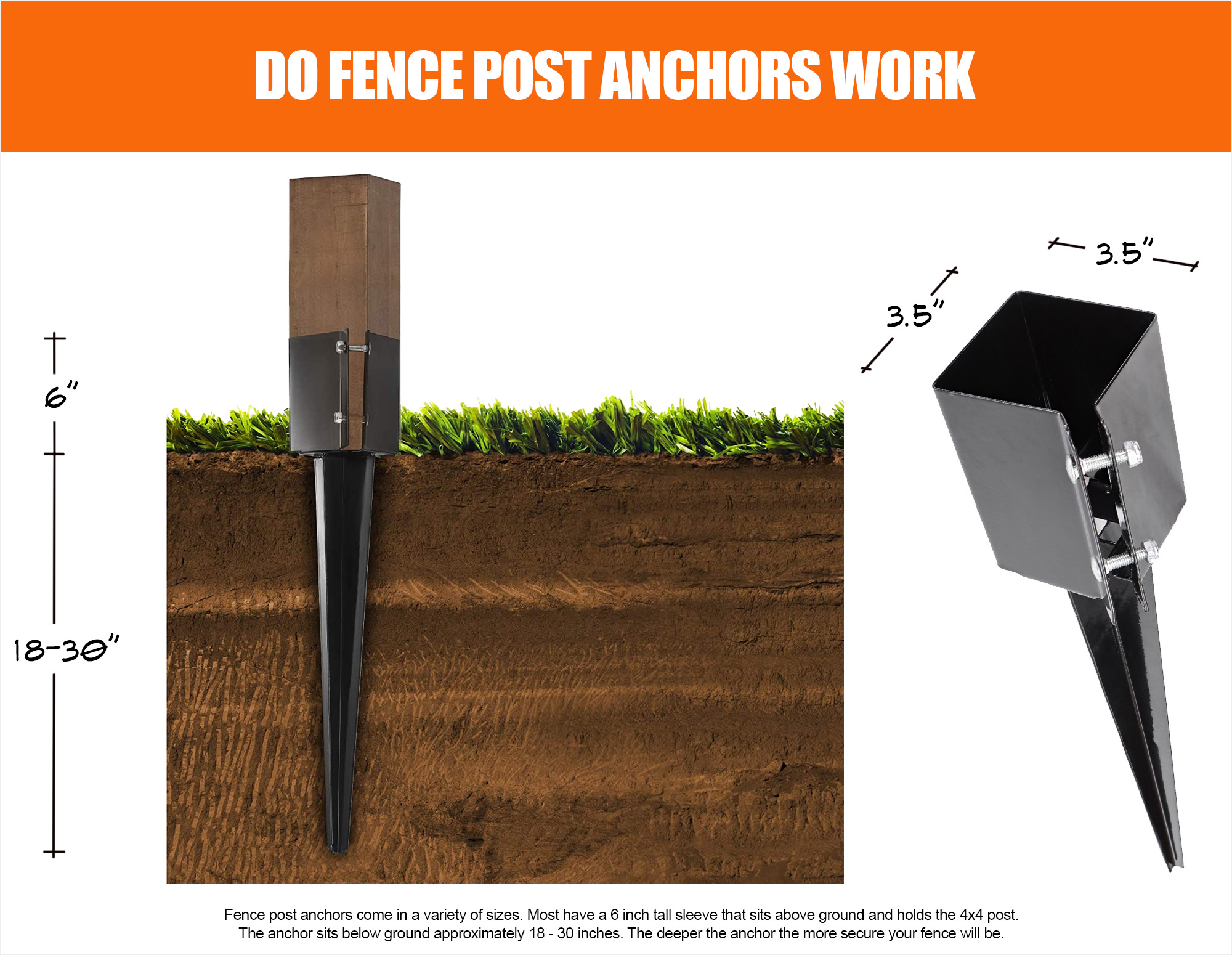Do Fence Post Anchors Work?
Fence post anchors can support a fence without digging holes or pouring concrete. They’re easy to use and take a lot of labor out of fence building. Each anchor has two parts. A sleeve that extends about 6 inches above the ground and a spike that’s driven into the dirt. Post anchors come in a variety of spike depths ranging from 18 inches to around 30 inches. However the sleeve is always around 6 inches. The deeper the spike, the stronger your fence will be. Use a sledge hammer and a block of wood to drive the post anchor into the ground. Don’t hit the metal directly with the hammer because you could damage it. Once the anchor is driven all the way into the ground, slide the 4×4 post into the sleeve. Then tighten the sleeve bolts.
Fence post anchor spikes are a great way to quickly set a fence post. Simply drive them into the ground and bolt in the fence post. However, they do have some limitations. Because anchors are relatively light and shallow, they’re not as strong as setting the fence post into concrete. As a general rule of thumb, a fence post should be about 1/3rd to 1/2 in the ground. For example, a 6 ft high fence should have a post that’s buried between 2 feet and 3 feet under ground. If you follow this rule, post anchors are too shallow for tall fences.
Another downside is that post anchors don’t use concrete. So they’re easy to pull up in heavy winds. But this can also be an advantage. If you ever have to move the fence, the posts are easy to pull out of the ground and reuse.
What Is A Fence Post Anchor?
A fence post anchor is designed to support a fence post without requiring a hole or concrete. They’re made from galvanized steel and usually powder coated black.
The anchor consists of two parts. The first is a 6 inch sleeve with several bolts that extends out of the ground when the spike is driven in. Once the anchor is set in place, a 4×4 can be inserted into the sleeve and tightened.
The second is a spike that’s usually between 18 – 30 inches long. This is what anchors the fence post to the ground.
Due to their heavy duty steel construction, a fence post anchor spike will last for years without rotting or rusting.
The bolts are also made from stainless steel which does not rust.
Because both the bolts and anchor are made from galvanized or stainless steel, they’re safe to use outdoors in any weather.
How To Install A Fence Post Anchor Spike
Installing a fence post anchor spike is fast and easy. And it doesn’t require any digging or concrete work.
Set the spike on your mark and drive it into the ground using a sledge hammer. Don’t hit the anchor directly with the hammer. The metal to metal contact can damage the anchor or crack the powder coating. Instead, use a wood block.
I like to insert a 1 foot piece of 4×4 into the sleeve. I hit the 4×4 with my sledge instead of the metal.
When you drive the anchor into the ground, make sure it’s perfectly level and plumb. If you drive the anchor at an angle, your fence post will be at an angle too. And there’s no way to adjust the post once the anchor is in. It has to be driven in perfectly or the fence will lean. This is one of the disadvantages to using anchors. It’s not as forgiving as concrete.
Keep hitting the anchor until the spike is all the way into the ground. The base of the sleeve should be right up against the dirt. Don’t drive the sleeve portion of the anchor into the dirt.
Once the anchor is set in place, insert the 4×4 post into the sleeve. Finally, tighten the bolts.
Some post anchors also have holes where you can drive in screws to help hold the post in place. If you’re anchor has these holes, make sure to use exterior grade screws or bolts.
How to Set Fence Posts With Fence Post Anchors
Building a fence without digging or mixing concrete is easy using post anchors. The hardest part is laying out the fence and driving the anchors.
here’s a list of the tools you’ll need:
- Sledgehammer: I use a mini sledge whenever possible but in hard ground a large sledgehammer works best.
- Wood Block: I use a 1 foot section of 4×4. You should never directly hit the anchor with a hammer because you could damage the metal or coating. Hit the wood instead.
- Level: It’s very important that you install the anchors level.
- Marking Equipment: I always bring paint, a tape measure and some string with stakes.
Start by marking out where each post goes. Use the string and stakes to mark the fence line. Then use the tape measure and paint to mark each post location.
Once the posts are all marked, start driving in the anchors.
It’s super important that every anchor is driven into the ground perfectly level. If the anchor is tilted even a little, the fence will lean.
Once all the anchors are in, insert the posts and bolt them tight. Then start installing the fence sections.
How Do You Secure A Fence Post Without Digging?
The best way to secure a fence post without digging is with a post anchor spike. Instead of digging a hole to put the post in, you simply drive in the spike and bolt the posts in place.
Fence post anchors work without any digging or concrete. The spike is deep enough to support the weight of most fences. The deeper the spike, the more support it provides.
One of the benefits of using a fence post anchor spike is how fast and easy a fence is to build. You don’t have to do any digging or mix any concrete. This makes the job easier and much faster.
When you set fence posts with concrete, you have to dig a deep hole first. Every post needs a hole and lots of concrete. With anchors, you simply drive one spike per post. There’s zero digging required.
Once you’ve pounded the fence post anchor spike fully into the ground, simply insert the post and bolt it in place.
The main tool you need to install fence post anchors is a sledge hammer. Unless the ground is really hard, a mini sledge is usually enough. However, if you’re driving into hard ground I’d recommend a full size sledge.
Fence post anchor spikes are very stable, but they pull out vertically much easier than concrete. This can be a disadvantage in high upward wind drafts but an advantage if you should ever need to move the fence. Simply unbolt and remove the post, pull out the anchor and reuse it.
Because the post doesn’t go into the ground, there’s less chance it will rot. However, if it does rot, changing the post is easy with an anchor. Simple unbolt the post, remove and replace it with a new one. It’s fast and easy work.
Helpful Tips For Installing Fence Post Anchors
The only challenge when installing fence post anchors is keeping them level when you drive them into the ground. If they’re off even a little the post will lean. And you can’t adjust them later. If it’s not something you can do yourself, bring a friend.
While setting the anchor spikes, check that they’re level after every few hits. The first few hits are the most important. Once you get 6 inches or so in the ground the anchor will stay pretty much on the same angle unless you hit it out of level.
Make sure not to drive any of the sleeve into the ground. Post anchors are designed so that the post stays above grade. This helps prevent rotting.
If the ground is really hard, try wetting it a bit. Wet soil is usually easier to drive a spike into than hard soil.
If that doesn’t work, try banging in a post hole digging bar. They’re much thinner than the spike and work like drilling in a pilot hole.
If you insert a 2 – 3 foot section of post into the sleeve you can drive the anchor using a post hole banger instead of a sledgehammer.
Are Fence Post Anchors More Expensive Than Concrete?
Fence post anchor spikes cost around $20 – $30 per spike. Compare that to an 80 lb. bags of Quikrete 3500 which averages around $5 per bag or a 60 lb. bag of fast setting Quikrete costing around $6 per bag.
At first glance, the spike looks a lot more expensive than the concrete, however, you can drive in a post anchor without any digging or mixing concrete.
A typical anchor spike can be installed in just a few minutes. using anchor spikes is much faster than setting the fence posts in concrete. In some cases, I can actually install the anchor spikes for an entire fence job faster than digging a single hole and filling it with concrete.
When considering time, which if you do this for a living means money, using post anchors is much cheaper.
Then there’s the long term costs to consider.
Since wood posts don’t go into the ground when you use post anchors, they don’t typically rot. This can save you a lot of money on potential repairs.
And anchor posts can easily be moved and reused someplace else. With concrete, if you need to move the fence, the posts are usually demolished and replaced. Most people don’t even try to reuse posts set in concrete. It’s a lot of labor and not usually worth the effort.
How Do You Secure A Fence Post Without Concrete?
There are a few ways to secure a fence post without using concrete.
Fence posts can be set directly into the dirt if they’re made from a material that won’t rot.
A better way to anchor the post is with gravel. Dog you’re post hole, fill the bottom with an inch or two of compacted gravel, insert the post, and finally fill the sides with more gravel. Setting the post in gravel provides drainage which helps prevent rotting.
You can also secure a fence post without concrete by using expanding foam. I recommend using Sika fence post mix. Simple dig your hole, insert the post and pour the expanding foam around the sides of the post. Hold the post level while the foam expands around it. I like to use a bit of gravel below the post for drainage.
Finally, you can secure a fence post without concrete using a post anchor spike. Drive the spike into the ground, set your post into the sleeve and tighten the bolts. It’s fast and easy to do and doesn’t require any digging or concrete.
Do Fence Post Spikes Work?
Fence post spikes work really well to support most fences. As a basic rule of thumb, a fence post should be about 1/3 to 1/2 of it’s total length below ground. The typical post anchor is 18 inches to 30 inches below ground. If you follow the rule, it means you can support a fence around 7 1/2 feet tall.
The lighter and lower the fence, the better the anchors generally work.
I like to use post anchors to support fences that have a few corners and anchor back to the house. The house and 90 degree corners help stabilize the fence.
Anchors are shaped like a spike. This makes them easier to drive into the ground but it also makes them easy to pull back out. For this reason I don’t use them in areas that have updraft winds.
Anchors work really well with chain-link fences. Updrafts aren’t typically a problem because winds blows through the fence. And chain-link fences are usually lighter and lower than solid privacy fences.
Summary: Do Fence Post Anchors Work?
Fence post anchors work without digging holes or pouring concrete. They’re easy to use and take a lot of labor out of fence building. Each anchor has two parts. A sleeve that extends about 6 inches above the ground and a spike that’s driven into the dirt. Post anchors come in a variety of spike depths ranging from 18 inches to around 30 inches. However the sleeve is always around 6 inches. The deeper the spike, the stronger your fence will be. Use a sledge hammer and a block of wood to drive the post anchor into the ground. Don’t hit the metal directly with the hammer because you could damage it. Once the anchor is driven all the way into the ground, slide the 4×4 post into the sleeve. Then tighten the sleeve bolts.
Fence post anchor spikes are a great way to quickly set a fence post. However, they do have some limitations. Because anchors are relatively light and shallow, they’re not as strong as setting the fence post into concrete. As a general rule of thumb, a fence post should be about 1/3rd to 1/2 in the ground. For example, a 6 ft high fence should have a post that’s buried between 2 feet and 3 feet under ground. If you follow this rule, post anchors are too shallow for tall fences.
Another downside is that post anchors don’t use concrete. So they’re easy to pull up in heavy winds. But this can also be an advantage. If you ever have to move the fence, the posts are easy to pull out of the ground and reuse.
If you have any questions about post anchors, email any time.























